中华文化的象征(中英对照)
- 格式:ppt
- 大小:6.63 MB
- 文档页数:19

中国传统文化象征Traditional Chinese culture is a rich tapestry of beliefs, values, customs, arts, and practices that have shaped theChinese society for thousands of years. It is a reflection ofthe wisdom, spirituality, and creativity of the Chinese people. Here are some of the key symbols and elements that represent traditional Chinese culture:1. Yin and Yang:Yin and Yang are two opposing forces that are interconnected and interdependent. They represent the balance and harmony ofthe universe and are found in various aspects of Chinese culture. Yin is associated with the feminine, darkness, cold, and passivity, while Yang represents the masculine, brightness, warmth, and activity.2. Five Elements:The five elements, also known as Wu Xing, are fundamental building blocks in traditional Chinese philosophy and medicine. They are wood, fire, earth, metal, and water, and they represent different aspects of nature. Each element has its unique characteristics and properties and interacts with the others to create a harmonious balance in nature.3. Chinese Calligraphy:Chinese calligraphy is the art of writing Chinese characters with a brush and ink. It is considered one of the highest forms of artistic expression and is deeply rooted in Chinese culture. Calligraphy is not just about writing, but it also embodies the spirit, rhythm, and beauty of the Chinese language. It is often used to convey deep philosophical and spiritual meanings.4. Chinese Tea Culture:Tea has been an integral part of Chinese culture for centuries. It symbolizes harmony, purity, and tranquility. The art of tea preparation and appreciation is highly cherished, and tea ceremonies are often conducted as a way to cultivate mindfulness and foster social connections. Chinese tea culture emphasizes the appreciation of tea's aroma, taste, and color.5. Chinese Painting:Chinese painting is a traditional art form that dates back thousands of years. It is characterized by its use of brush and ink to depict landscapes, people, flowers, and birds. Chinese painting emphasizes harmony, simplicity, and expressiveness. It often seeks to capture the essence and spirit of the subject rather than the realistic representation.6. Traditional Festivals:7. Feng Shui:Feng Shui is an ancient Chinese practice that seeks to create harmony and balance in one's environment. It is based on the belief that the arrangement of objects and living spaces can influence the energy flow and bring good fortune. Feng Shui principles are often applied in the design and layout of homes, offices, and gardens.8. Chinese Traditional Medicine:In conclusion, traditional Chinese culture is a treasure trove of symbols and elements that represent the wisdom, spirituality, and creativity of the Chinese people. From concepts like Yin and Yang and the five elements to art forms like calligraphy and painting, these symbols provide insights into the rich cultural heritage of China. Traditional Chinese festivals, tea culture, Feng Shui, and traditional medicine further exemplify the depth and breadth of this vibrant culture.。

中华思想⽂化术语③“上善若⽔”咋翻译?20个中英⽂对照词了解传统⽂化点击上⽅微⾔教育,⼀键关注我们!近⽇,“中华思想⽂化术语传播⼯程”第⼆批术语对外发布,对“居安思危”“上善若⽔”等反映中华传统⽂化特征与思维⽅式的核⼼术语,作出了简明的中⽂释义和英⽂翻译。
今天,“微⾔教育”继续向⼤家亮出这些词语,我们⼀起学习吧。
【英译】Jingjie (Visionary World)【释义】“境界”本指疆域边界、⼟地边界,后来在佛经翻译中,“境界”⼀词被⽤于精神领域,指⼈破除对于物质世界的沉迷后所达到的精神层次或修为境域。
作为⽂艺术语,主要指⽂艺作品中所表现出的审美层次和境域,是作者的创造⼒、理解⼒和审美能⼒在精神层⾯的综合呈现。
有境界的作品是作者真实⼈格的显现,具备超越凡俗的意味,更能引发读者的共鸣,激发读者的想象,甚⾄提升读者的感受。
“意境”形成较早,⽽“境界”主要受中唐以后佛教思想的影响⽽形成。
近代学者王国维《⼈间词话》对境界的阐释最多。
王国维往往将“意境”与“境界”概念通⽤。
他构建了融合西⽅美学与中国古典美学为⼀体的“境界论”。
但⼀般说来,意境侧重作者主观寓意与作品形象的完满融会,通过鉴赏使想象得到发挥,⽽境界则突出⼼灵感悟使艺术形象得到升华,强调⼼灵世界对于作品层次的提升。
【英译】Aesthetic Conception TranscendsConcrete Objects Described.【释义】诗⽂中的审美意境往往在物象之外,需要鉴赏者领悟其中的精神之美。
“境”指作品所创造的审美意境,“象”是作品中所呈现出的具体物象。
诗歌由语⾔⽂字写成,所描写的都是⼀个个物象,在这些具体的物象之外,能够形成整体的审美情境。
唐代诗⼈刘禹锡⾸次提出这个命题,表达对诗歌意趣的思考,强调⽂字与物象是确切的,⽽审美情境却是微妙⽽难以⾔传的。
在古典诗论意境说的形成过程中,“境⽣象外”是⼀个重要的发展阶段。
【英译】Be on Alert Against PotentialDanger When Living in Peace【释义】处在安宁的环境中,要想到可能出现的危难。

莫逆之交:bosom friends总角之交:friendship between people who are friends since childhood一般作宾语,指儿时的朋友。
总角:古代未成年的人把头发扎成髻。
借指童年时期,幼年。
总角是八九岁至十三四岁的少年,古代儿童将头发分作左右两半,在头顶各扎成一个结,形如两个羊角,故称“总角”。
贫贱之交:friendship between people who are poverty-stricken and from humble circumstances杵臼之交:friendship between people who do not care about the financial condition and social status of each other 杵:舂米的木棒;臼:石臼。
比喻交朋友不计较贫富和身分。
君子之交:friendship between gentlemen小人之交:friendship between villains狐朋狗友:people who often gather together doing something meaningless and even illegal棋友/牌友/球友:people who often meet to play chess, poker, ball. etc.战友:people who get to know each other while serving in the same army unit普通老百姓交的朋友谓“布衣之交”;有钱人与没钱人交朋友谓“车笠之交”;在逆境中结交的朋友称“患难之交”;吃喝玩乐结交的朋友称“酒肉之交”;年岁差别大,行辈不同而交情深厚的朋友称“忘年之交”;幼年相交的朋友称“竹马之交”;交情深厚的朋友谓“肺腑之交”;亲密无间的朋友谓“胶漆之交”;生死与共的朋友谓“生死之交”;情投意合的朋友称“莫逆之交”;哪怕砍头也不改变友谊的朋友称“刎颈之交”;无意中相遇而结成的朋友称“邂逅之交”;在道义上互相支持的朋友称“君子之交”;只见过一次面,交情不深的朋友称“一面之交”;仅点头打招呼,感情不深的朋友称“点头之交”;平淡而浮泛交往的朋友称“泛泛之交”;见过面但不熟悉的人称“半面之交”;旧时结拜的兄弟姊妹称“八拜之交”;交友不嫌贫贱称“杵逆之交”;宝贵而有价值的交往称“金玉之交”。
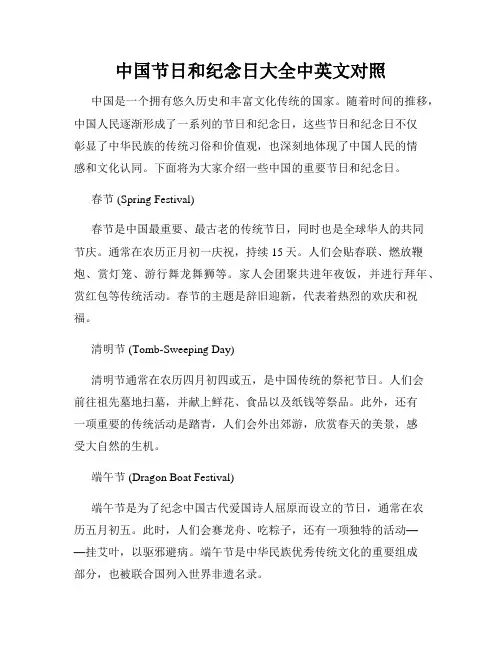
中国节日和纪念日大全中英文对照中国是一个拥有悠久历史和丰富文化传统的国家。
随着时间的推移,中国人民逐渐形成了一系列的节日和纪念日,这些节日和纪念日不仅彰显了中华民族的传统习俗和价值观,也深刻地体现了中国人民的情感和文化认同。
下面将为大家介绍一些中国的重要节日和纪念日。
春节 (Spring Festival)春节是中国最重要、最古老的传统节日,同时也是全球华人的共同节庆。
通常在农历正月初一庆祝,持续15天。
人们会贴春联、燃放鞭炮、赏灯笼、游行舞龙舞狮等。
家人会团聚共进年夜饭,并进行拜年、赏红包等传统活动。
春节的主题是辞旧迎新,代表着热烈的欢庆和祝福。
清明节 (Tomb-Sweeping Day)清明节通常在农历四月初四或五,是中国传统的祭祀节日。
人们会前往祖先墓地扫墓,并献上鲜花、食品以及纸钱等祭品。
此外,还有一项重要的传统活动是踏青,人们会外出郊游,欣赏春天的美景,感受大自然的生机。
端午节 (Dragon Boat Festival)端午节是为了纪念中国古代爱国诗人屈原而设立的节日,通常在农历五月初五。
此时,人们会赛龙舟、吃粽子,还有一项独特的活动——挂艾叶,以驱邪避病。
端午节是中华民族优秀传统文化的重要组成部分,也被联合国列入世界非遗名录。
中秋节 (Mid-Autumn Festival)中秋节是一个家庭团聚的节日,通常在农历八月十五。
人们会赏月、吃月饼、赏菊花等。
中秋节的核心是月亮,代表着团聚和祝福。
此外,也有丰富多样的民间故事和传说与中秋节相关联,如嫦娥奔月、吴刚伐桂等。
国庆节 (National Day)国庆节是中国的国家节日,于每年的十月一日庆祝,持续7天。
这是一个庆祝中华人民共和国成立的节日,人们会进行各种形式的庆祝活动,如升国旗仪式、阅兵式、文艺演出等。
国庆节是中国人民爱国主义情感的集中表达,也是对中华民族伟大历史和深厚文化底蕴的庆祝。
五四青年节 (Youth Day)五四青年节是为了纪念1919年五四运动而设立的节日,同时也是世界青年节。
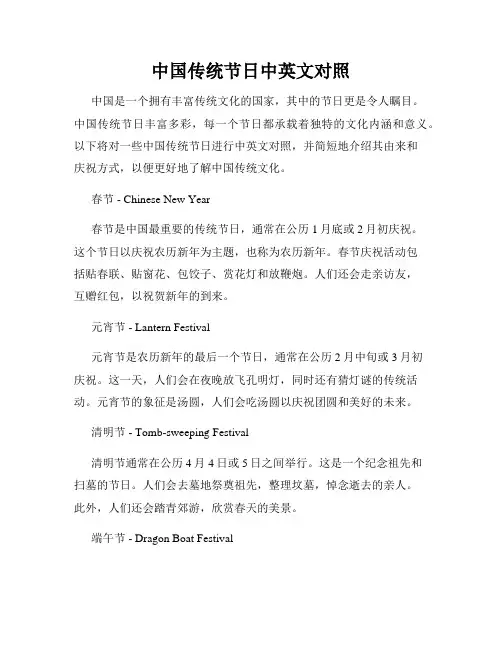
中国传统节日中英文对照中国是一个拥有丰富传统文化的国家,其中的节日更是令人瞩目。
中国传统节日丰富多彩,每一个节日都承载着独特的文化内涵和意义。
以下将对一些中国传统节日进行中英文对照,并简短地介绍其由来和庆祝方式,以便更好地了解中国传统文化。
春节 - Chinese New Year春节是中国最重要的传统节日,通常在公历1月底或2月初庆祝。
这个节日以庆祝农历新年为主题,也称为农历新年。
春节庆祝活动包括贴春联、贴窗花、包饺子、赏花灯和放鞭炮。
人们还会走亲访友,互赠红包,以祝贺新年的到来。
元宵节 - Lantern Festival元宵节是农历新年的最后一个节日,通常在公历2月中旬或3月初庆祝。
这一天,人们会在夜晚放飞孔明灯,同时还有猜灯谜的传统活动。
元宵节的象征是汤圆,人们会吃汤圆以庆祝团圆和美好的未来。
清明节 - Tomb-sweeping Festival清明节通常在公历4月4日或5日之间举行。
这是一个纪念祖先和扫墓的节日。
人们会去墓地祭奠祖先,整理坟墓,悼念逝去的亲人。
此外,人们还会踏青郊游,欣赏春天的美景。
端午节 - Dragon Boat Festival端午节是一个具有悠久历史的节日,通常在公历6月初庆祝。
这个节日源于纪念古代爱国诗人屈原,也是一项庆祝夏天到来的活动。
人们会参加龙舟赛、包粽子和挂艾草。
象征食物是粽子,人们吃粽子以保护自己免受邪恶和疾病的侵袭。
中秋节 - Mid-Autumn Festival中秋节是农历八月十五,通常在公历9月底或10月初庆祝。
这个节日庆祝秋天的丰收和团圆。
人们会赏月、品尝月饼以及举办家庭聚会。
月饼是中秋节的特色食物,馅料的种类多样,寓意着团圆和祝福。
重阳节 - Double Ninth Festival重阳节通常在公历9月初或10月底庆祝,也被称为老人节。
此节日的由来与古代传说有关,人们会爬山、采菊、追溯阳光,并祝福年长的亲人和朋友。
重阳节也是缅怀祖先和尊重老年人的时间。
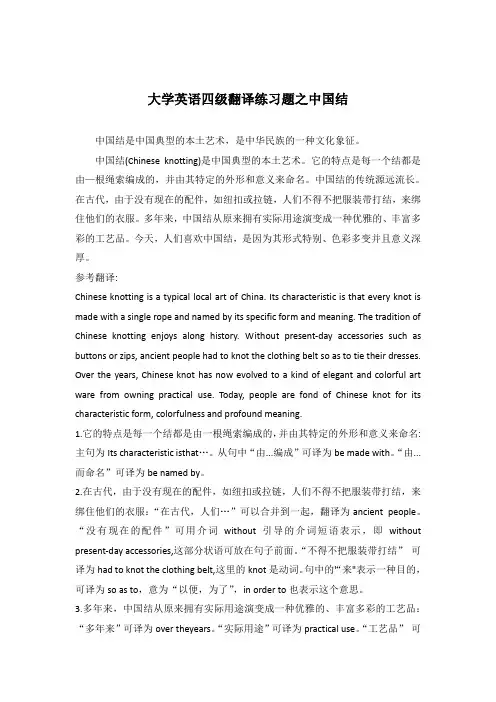
大学英语四级翻译练习题之中国结中国结是中国典型的本土艺术,是中华民族的一种文化象征。
中国结(Chinese knotting)是中国典型的本土艺术。
它的特点是每一个结都是由—根绳索编成的,并由其特定的外形和意义来命名。
中国结的传统源远流长。
在古代,由于没有现在的配件,如纽扣或拉链,人们不得不把服装带打结,来绑住他们的衣服。
多年来,中国结从原来拥有实际用途演变成一种优雅的、丰富多彩的工艺品。
今天,人们喜欢中国结,是因为其形式特别、色彩多变并且意义深厚。
参考翻译:Chinese knotting is a typical local art of China. Its characteristic is that every knot is made with a single rope and named by its specific form and meaning. The tradition of Chinese knotting enjoys along history. Without present-day accessories such as buttons or zips, ancient people had to knot the clothing belt so as to tie their dresses. Over the years, Chinese knot has now evolved to a kind of elegant and colorful art ware from owning practical use. Today, people are fond of Chinese knot for its characteristic form, colorfulness and profound meaning.1.它的特点是每一个结都是由一根绳索编成的,并由其特定的外形和意义来命名:主句为Its characteristic isthat…。
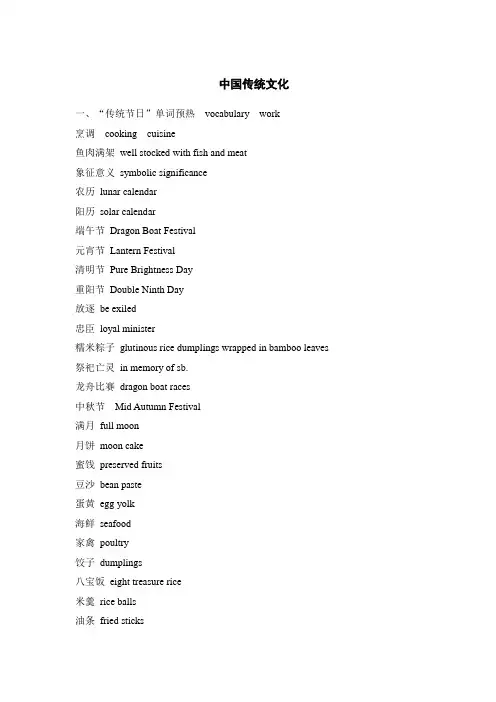
中国传统文化一、“传统节日”单词预热vocabulary work烹调cooking cuisine鱼肉满架well stocked with fish and meat象征意义symbolic significance农历lunar calendar阳历solar calendar端午节Dragon Boat Festival元宵节Lantern Festival清明节Pure Brightness Day重阳节Double Ninth Day放逐be exiled忠臣loyal minister糯米粽子glutinous rice dumplings wrapped in bamboo leaves 祭祀亡灵in memory of sb.龙舟比赛dragon boat races中秋节Mid Autumn Festival满月full moon月饼moon cake蜜饯preserved fruits豆沙bean paste蛋黄egg yolk海鲜seafood家禽poultry饺子dumplings八宝饭eight treasure rice米羹rice balls油条fried sticks麻花fried twisted stick炒面Chaomian叉烧包steamed bun with roast pork粥porridge芋头taro葱油饼pan-fried cake with sesame seeds and green onion有关春节的常用词放鞭炮let off firecrackers耍龙灯play the dragon lantern耍狮子play the lion dance拜年pay a new-year callChinese to English:1. 玉器是光辉灿烂的中华民族历史文化宝库中一枝异彩独放的奇葩。
中国玉器在新石器时代的河姆渡文化时期就开始出现。
7000年来一直延续不断,发展至今。
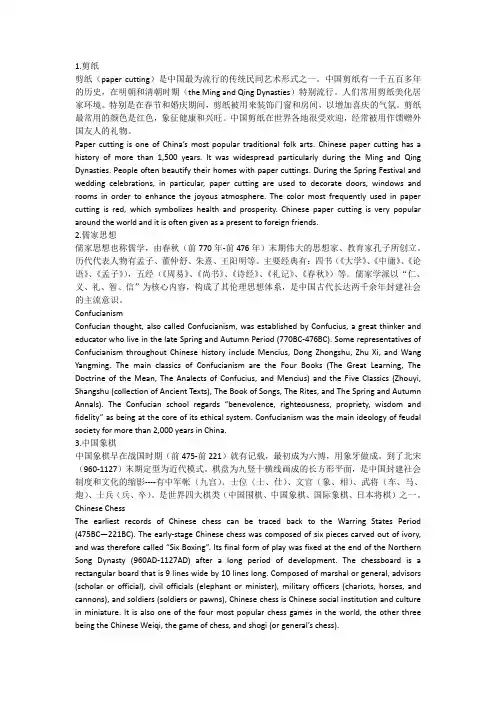
1.剪纸剪纸(paper cutting)是中国最为流行的传统民间艺术形式之一。
中国剪纸有一千五百多年的历史,在明朝和清朝时期(the Ming and Qing Dynasties)特别流行。
人们常用剪纸美化居家环境。
特别是在春节和婚庆期间,剪纸被用来装饰门窗和房间,以增加喜庆的气氛。
剪纸最常用的颜色是红色,象征健康和兴旺。
中国剪纸在世界各地很受欢迎,经常被用作馈赠外国友人的礼物。
Paper cutting is one of China’s most popular traditional folk arts. Chinese paper cutting has a history of more than 1,500 years. It was widespread particularly during the Ming and Qing Dynasties. People often beautify their homes with paper cuttings. During the Spring Festival and wedding celebrations, in particular, paper cutting are used to decorate doors, windows and rooms in order to enhance the joyous atmosphere. The color most frequently used in paper cutting is red, which symbolizes health and prosperity. Chinese paper cutting is very popular around the world and it is often given as a present to foreign friends.2.儒家思想儒家思想也称儒学,由春秋(前770年-前476年)末期伟大的思想家、教育家孔子所创立。
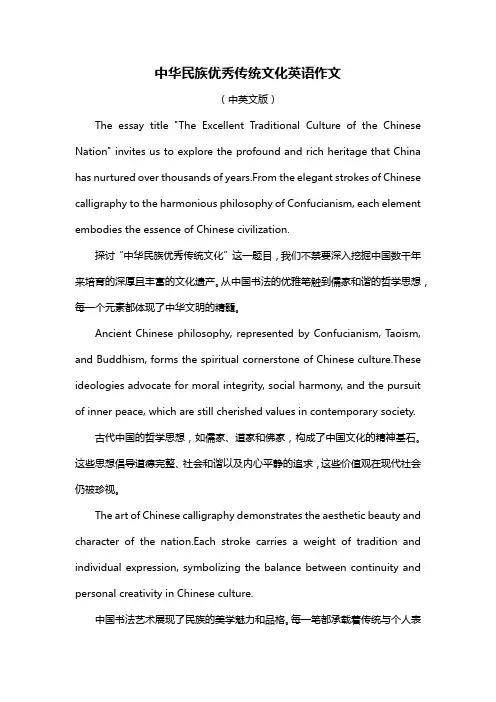
中华民族优秀传统文化英语作文(中英文版)The essay title "The Excellent Traditional Culture of the Chinese Nation" invites us to explore the profound and rich heritage that China has nurtured over thousands of years.From the elegant strokes of Chinese calligraphy to the harmonious philosophy of Confucianism, each element embodies the essence of Chinese civilization.探讨“中华民族优秀传统文化”这一题目,我们不禁要深入挖掘中国数千年来培育的深厚且丰富的文化遗产。
从中国书法的优雅笔触到儒家和谐的哲学思想,每一个元素都体现了中华文明的精髓。
Ancient Chinese philosophy, represented by Confucianism, Taoism, and Buddhism, forms the spiritual cornerstone of Chinese culture.These ideologies advocate for moral integrity, social harmony, and the pursuit of inner peace, which are still cherished values in contemporary society.古代中国的哲学思想,如儒家、道家和佛家,构成了中国文化的精神基石。
这些思想倡导道德完整、社会和谐以及内心平静的追求,这些价值观在现代社会仍被珍视。
The art of Chinese calligraphy demonstrates the aesthetic beauty and character of the nation.Each stroke carries a weight of tradition and individual expression, symbolizing the balance between continuity and personal creativity in Chinese culture.中国书法艺术展现了民族的美学魅力和品格。
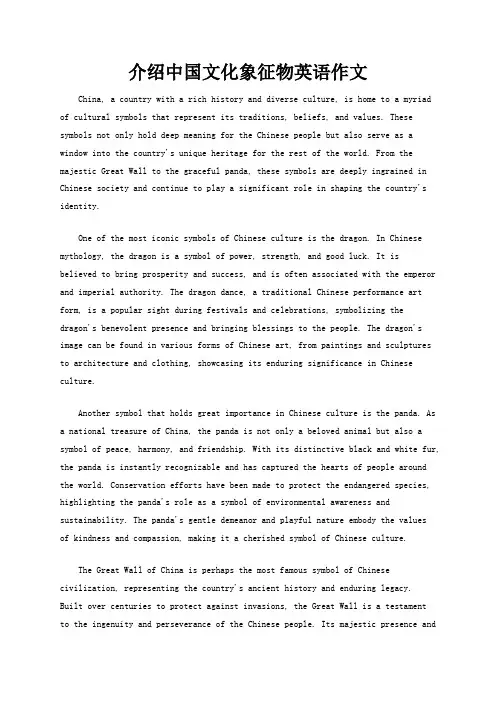
介绍中国文化象征物英语作文China, a country with a rich history and diverse culture, is home to a myriad of cultural symbols that represent its traditions, beliefs, and values. These symbols not only hold deep meaning for the Chinese people but also serve as a window into the country's unique heritage for the rest of the world. From the majestic Great Wall to the graceful panda, these symbols are deeply ingrained in Chinese society and continue to play a significant role in shaping the country's identity.One of the most iconic symbols of Chinese culture is the dragon. In Chinese mythology, the dragon is a symbol of power, strength, and good luck. It isbelieved to bring prosperity and success, and is often associated with the emperor and imperial authority. The dragon dance, a traditional Chinese performance art form, is a popular sight during festivals and celebrations, symbolizing thedragon's benevolent presence and bringing blessings to the people. The dragon's image can be found in various forms of Chinese art, from paintings and sculptures to architecture and clothing, showcasing its enduring significance in Chinese culture.Another symbol that holds great importance in Chinese culture is the panda. As a national treasure of China, the panda is not only a beloved animal but also a symbol of peace, harmony, and friendship. With its distinctive black and white fur, the panda is instantly recognizable and has captured the hearts of people around the world. Conservation efforts have been made to protect the endangered species, highlighting the panda's role as a symbol of environmental awareness and sustainability. The panda's gentle demeanor and playful nature embody the valuesof kindness and compassion, making it a cherished symbol of Chinese culture.The Great Wall of China is perhaps the most famous symbol of Chinese civilization, representing the country's ancient history and enduring legacy.Built over centuries to protect against invasions, the Great Wall is a testamentto the ingenuity and perseverance of the Chinese people. Its majestic presence andformidable structure have captivated visitors from all corners of the globe, making it a symbol of strength, unity, and resilience. The Great Wall serves as a reminder of China's past glory and the importance of preserving its cultural heritage for future generations.Chinese calligraphy, with its elegant strokes and intricate characters, is another symbol of China's cultural heritage. Dating back thousands of years, calligraphy is considered a high art form in China, reflecting the beauty and sophistication of the Chinese language. Each brushstroke is imbued with meaning and emotion, capturing the essence of the written word in a visual form. Calligraphy is not only a means of communication but also a form of artistic expression, showcasing the skill and creativity of the calligrapher. From ancient scrolls to modern signage, calligraphy remains a vital part of Chinese culture, embodying the grace and beauty of the written word.The Chinese zodiac, based on a twelve-year cycle with each year represented by an animal sign, is a popular symbol in Chinese culture that is believed to influence one's personality and destiny. Each animal sign is associated with certain traits and characteristics, shaping the individual's identity and relationships. The Chinese zodiac is often used to determine compatibility in relationships, predict fortunes, and guide decision-making. People born in the Year of the Dragon, for example, are believed to be strong, ambitious, and charismatic, while those born in the Year of the Rabbit are considered gentle, compassionate, and artistic. The Chinese zodiac serves as a cultural touchstone that connects people to their heritage and traditions, fostering a sense of unity and belonging within the community.In conclusion, Chinese culture is rich in symbolism, with each cultural symbol carrying deep meaning and significance for the Chinese people. From the powerful dragon to the gentle panda, these symbols reflect the values, beliefs, and traditions that have shaped Chinese society for millennia. As China continues to evolve and modernize, these cultural symbols remain a vital link to the country's past and a source of pride and inspiration for future generations. Through thepreservation and celebration of these symbols, China's cultural heritage will continue to thrive and flourish, serving as a beacon of tradition and identity in an ever-changing world.。
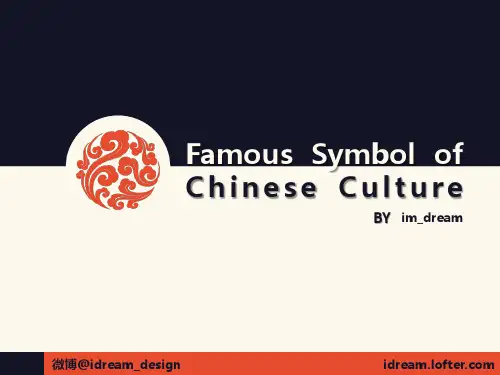
八拜之交:原表示世代有交情的两家弟子谒见对方长辈时的礼节,旧时也称异姓结拜的兄弟姐妹。
●friendship between sworn brothers or sisters●friendship between very close friends whounderstand each other and remend each otherat the sacrifice of their own interests莫逆之交:bosom friends总角之交:friendship between people who are friends since childhood一般作宾语,指儿时的朋友。
总角:古代未成年的人把头发扎成髻。
借指童年时期,幼年。
总角是八九岁至十三四岁的少年,古代儿童将头发分作左右两半,在头顶各扎成一个结,形如两个羊角,故称“总角〞。
贫贱之交:friendship between people who are poverty-stricken and from humble circumstances杵臼之交:friendship between people who do not care about the financial condition and social status of each other 杵:舂米的木棒;臼:石臼。
比喻交朋友不计较贫富和身分。
君子之交:friendship between gentlemen小人之交:friendship between villains狐朋狗友:people who often gather together doing something meaningless and even illegal棋友/牌友/球友:people who often meet to play chess, poker, ball. etc.战友:people who get to know each other while serving in the same army unit普通老百姓交的朋友谓“布衣之交〞;有钱人与没钱人交朋友谓“车笠之交〞;在逆境中结交的朋友称“患难之交〞;吃喝玩乐结交的朋友称“酒肉之交〞;年岁差异大,行辈不同而交情深厚的朋友称“忘年之交〞;幼年相交的朋友称“竹马之交〞;交情深厚的朋友谓“肺腑之交〞;亲密无间的朋友谓“胶漆之交〞;生死与共的朋友谓“生死之交〞;情投意合的朋友称“莫逆之交〞;哪怕砍头也不改变友谊的朋友称“刎颈之交〞;无意中相遇而结成的朋友称“邂逅之交〞;在道义上互相支持的朋友称“君子之交〞;只见过一次面,交情不深的朋友称“一面之交〞;仅点头打招呼,感情不深的朋友称“点头之交〞;平淡而浮泛交往的朋友称“泛泛之交〞;见过面但不熟悉的人称“半面之交〞;旧时结拜的兄弟姊妹称“八拜之交〞;交友不嫌贫贱称“杵逆之交〞;珍贵而有价值的交往称“金玉之交〞。
中国传统⽂化(中英对照)莫逆之交:bosom friends总⾓之交:friendship between people who are friends since childhood⼀般作宾语,指⼉时的朋友。
总⾓:古代未成年的⼈把头发扎成髻。
借指童年时期,幼年。
总⾓是⼋九岁⾄⼗三四岁的少年,古代⼉童将头发分作左右两半,在头顶各扎成⼀个结,形如两个⽺⾓,故称“总⾓”。
贫贱之交:friendship between people who are poverty-stricken and from humble circumstances杵⾅之交:friendship between people who do not care about the financial condition and social status of each other 杵:舂⽶的⽊棒;⾅:⽯⾅。
⽐喻交朋友不计较贫富和⾝分。
君⼦之交:friendship between gentlemen⼩⼈之交:friendship between villains狐朋狗友:people who often gather together doing something meaningless and even illegal棋友/牌友/球友:people who often meet to play chess, poker, ball. etc.战友:people who get to know each other while serving in the same army unit普通⽼百姓交的朋友谓“布⾐之交”;有钱⼈与没钱⼈交朋友谓“车笠之交”;在逆境中结交的朋友称“患难之交”;吃喝玩乐结交的朋友称“酒⾁之交”;年岁差别⼤,⾏辈不同⽽交情深厚的朋友称“忘年之交”;幼年相交的朋友称“⽵马之交”;交情深厚的朋友谓“肺腑之交”;亲密⽆间的朋友谓“胶漆之交”;⽣死与共的朋友谓“⽣死之交”;情投意合的朋友称“莫逆之交”;哪怕砍头也不改变友谊的朋友称“刎颈之交”;⽆意中相遇⽽结成的朋友称“邂逅之交”;在道义上互相⽀持的朋友称“君⼦之交”;只见过⼀次⾯,交情不深的朋友称“⼀⾯之交”;仅点头打招呼,感情不深的朋友称“点头之交”;平淡⽽浮泛交往的朋友称“泛泛之交”;见过⾯但不熟悉的⼈称“半⾯之交”;旧时结拜的兄弟姊妹称“⼋拜之交”;交友不嫌贫贱称“杵逆之交”;宝贵⽽有价值的交往称“⾦⽟之交”。
故宫故宫全景The Palace Museum has served as the royal residence during the Ming and Qing dynasties. It was here that a total of 24 monarchs ascended the throne and wielded power for some 500 years. The Palace Museum, as the most beautiful spot of interest throughout Beijing, is unique for its location: to the northwest is Beihai(North Sea) Park, famous for its white pagoda and rippling lake; to the west is the Zhongnahai (central and south sea); to the east lies the the Wangfujing Shopping Street; and to the north id Jinshan Park. Standing in the Wanchun (Everlasting Spring) Pavilion at the top of Jingshan(Charcoal Hill) Park, you overlook the skyline of the palace Museum. At the southern end of the palace is Tian` anmen (Gate of Heavenly Peace) and the famous square named after it . This is the symbol of the People` s Republic of China.A world-famous historical site, the Palace Museum is on the World Heritage List of UNESCO and is an embodiment of oriental civilization.The Palace Museum is rectangular in shape, 960 meters long from north to south and 750 meters wide from east to west, covering a space of 720,000 square meters of which 150,000 is building area . It has 9000-strong rooms in it . According to legend there are 9999.5 room-units in all .The wholecompound is enclosed by a 10-meter-hign wall and is accessed through four entrances, namely, the meridian Gate in the south ,the Gate of Military Prowess in the north, Donghua(Eastern Flowery ) Gate in the north, Donghua ( Eastern Flowery) Gate in the east and Xihua(Western Flowery ) Gate in the west. On each corner there is a turret consisted of 9 roof beams, 18 pillars and 72 ridge . Encircling the compound there is a 3,800-meter-long and 52 meter-wide moat, making the Palace Museum a self-defensive city-within-a city.译文:故宫旧称紫禁城。
中国龙对龙图腾的崇拜在中国大约已绵延了八千多年。
中国龙是古人将鱼,蛇,马,牛等动物与云雾,雷电等自然天象集合而成的一种神物。
中国龙的形成与中华民族的多元融合过程同步。
在中国人的心目中,龙具有振奋腾飞,开拓变化的寓意和团结凝聚的精神。
Chinese DragonDragon totem worship in China has been around for the last 8,000 years. The ancients in China considered the dragon (or Loong) a fetish that combines animals including the fish, snake, horse and ox with cloud, thunder, lightning and other natural celestial phenomena. The Chinese dragon was formed in accordance with the multicultural fusion process of the Chinese nation. To the Chinese, the dragon signifies innovation and cohesion.饺子饺子是深受中国人民喜爱的传统特色食品。
相传为古代医圣张仲景发明。
饺子的制作是包括:1)擀皮、2)备馅、3)包馅水煮三个步骤。
其特点是皮薄馅嫩,味道鲜美,形状独特,百食不厌。
民间有“好吃不过饺子”的俗语。
中国人接亲待友。
逢年过节都有包饺子吃的习俗,寓意吉利。
对崇尚亲情的中国人来说,“更岁交子”吃饺子,更是欢度除夕、辞旧迎新必不可少的内容。
DumplingsDumplings are one of the Chinese people’s favorite traditional dishes. According to an ancient Chinese legend, dumplings were first made by the medical saint—Zhang Zhongjing. There are three steps involved in making dumplings: 1) make dumpling wrappers out of dumpling flour; 2) prepare the dumpling stuffing; 3) make dumplings and boil them. With thin and elastic dough skin, freshen and tender stuffing, delicious taste, and unique shapes, dumplings are worth eating hundreds of times. There’s an old saying that claims, ―Nothing could be more delicious than dumplings.‖ During the Spring Festival and other holidays or when treating relatives and friends, Chinese people like to follow the auspicious custom of eating dumplings. To Chinese people who show high reverence for family love, having dumplings at the moment the old year is replaced by the new is an essential part of bidding farewell to the old and ushering in the New Year.针灸针灸是中医学的重要组成部分。